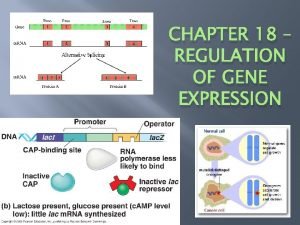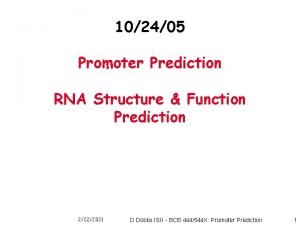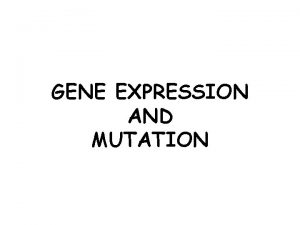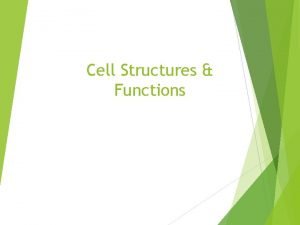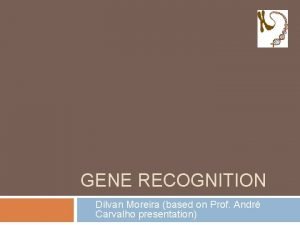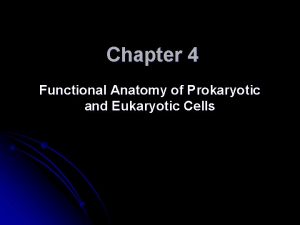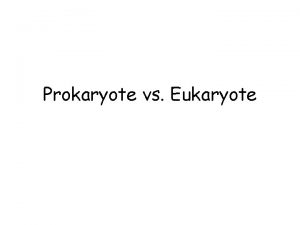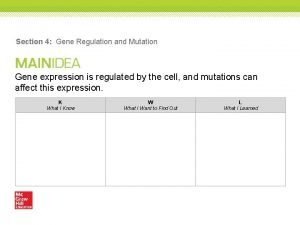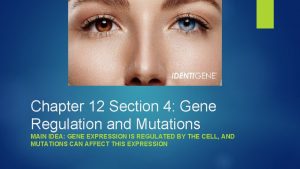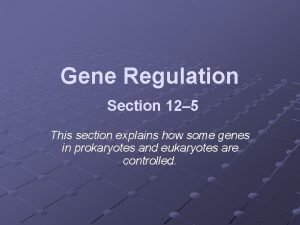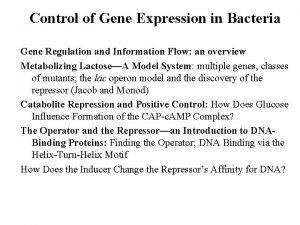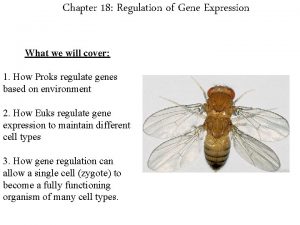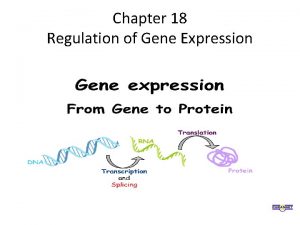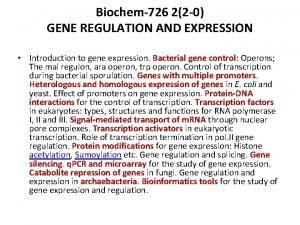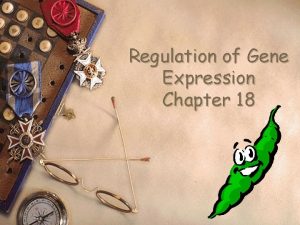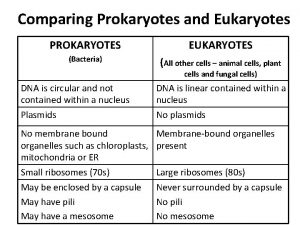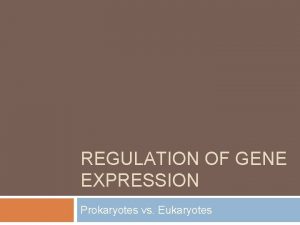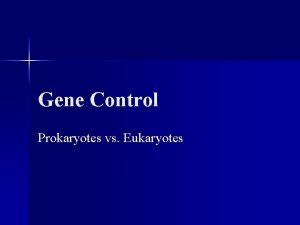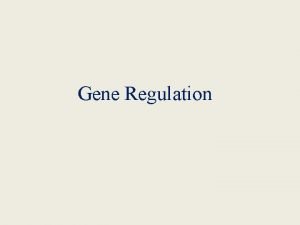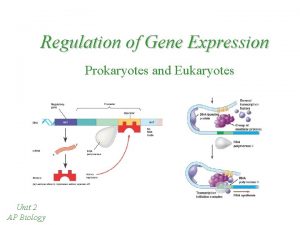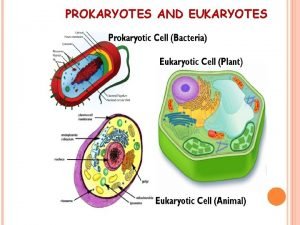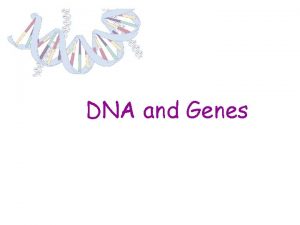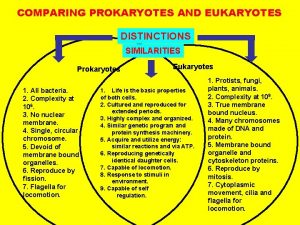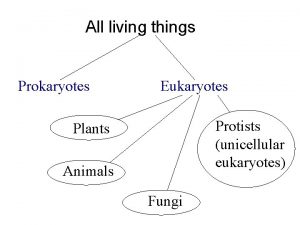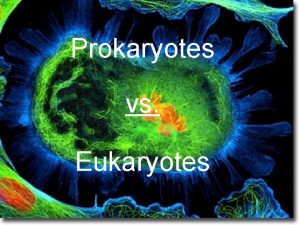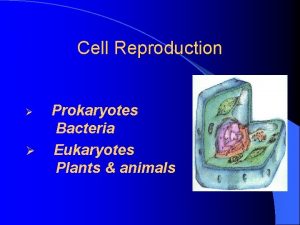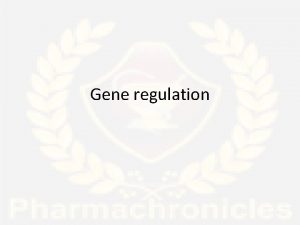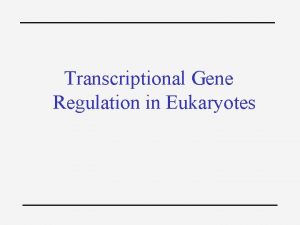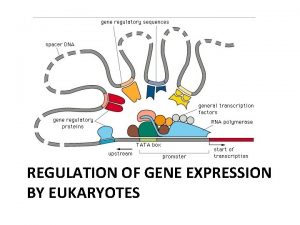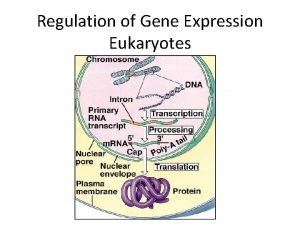Gene regulation in prokaryotes and eukaryotes How do























- Slides: 23


Gene regulation in prokaryotes and eukaryotes • How do organisms respond correctly to their environment? • How do they control their growth and development? • How do they control which genes are expressed? Copyright © 2003 Pearson Education, Inc. publishing as Benjamin Cummings

• The process by which genetic information flows from genes to proteins is called gene expression Prokaryotes Proteins interacting with DNA turn prokaryotic genes on or off in response to environmental changes Figure 11. 1 A Copyright © 2003 Pearson Education, Inc. publishing as Benjamin Cummings

genes for related enzymes are often controlled in groups called operons lac operon regulator gene promotor operator i gene codes for repressor protein p o z gene y gene binding site codes for of RNA b-galactosidase, polymerase which clips lactose molecules a gene codes for permease enzyme that transports lactose into cells DNA

lac operon regulator gene i gene RNA polymerase p promotor operator o z gene repressor protein blocks binding of RNA polymerase y gene a gene DNA no transcription repressor protein Regulatory proteins bind to control sequences in DNA and turn operons on or off

2 RNA polymerase binds to promoter p i gene o z gene y gene a gene DNA 3 transcription proceeds repressor m. RNA transcript lactose b-galactosidase 1 lactose the (inducer) inactivates the repressor so that it cannot bind to the operator permease galactose ne glucose c ell ra b m e m lactose

• Two types of repressor-controlled operons Promoter Operator Genes DNA Active repressor Tryptophan Inactive repressor Lactose lac OPERON Figure 11. 1 C Copyright © 2003 Pearson Education, Inc. publishing as Benjamin Cummings trp OPERON

Eukaryotic gene control • Transcription is a major control point • Individual genes are regulated, rather than operons • Activation is more important than repression Copyright © 2003 Pearson Education, Inc. publishing as Benjamin Cummings

Activators bind to enhancer regions of DNA and to other transcription factors Enhancers – These interactions turn the DNA transcription Activator proteins Transcription of eukaryotic Other factors proteins genes on or off Promoter Gene RNA polymerase Bending of DNA Figure 11. 8 Copyright © 2003 Pearson Education, Inc. publishing as Benjamin Cummings Transcription

Control of transcription • Control access of enzymes to DNA: 1. Methylation of DNA - inhibits 2. Acetylation of histones - promotes Copyright © 2003 Pearson Education, Inc. publishing as Benjamin Cummings

How do eukaryotes control genes of a single metabolic pathway? • genes for individual enzymes of one pathway are often located far apart in the genome • same enhancer region(s) common to all genes of a pathway. Copyright © 2003 Pearson Education, Inc. publishing as Benjamin Cummings

Eukaryotic RNA may be spliced in more than one way • After transcription, alternative splicing may generate two or more types of m. RNA from the same transcript Exons DNA RNA transcript RNA splicing m. RNA Copyright © 2003 Pearson Education, Inc. publishing as Benjamin Cummings or Figure 11. 9

Translation and later stages of gene expression are also subject to regulation • The lifetime of an m. RNA molecule helps determine how much protein is made • Initiation of translation Copyright © 2003 Pearson Education, Inc. publishing as Benjamin Cummings

• The protein may need to be activated in some way • Rate of protein degradation Folding of polypeptide and formation of S–S linkages Initial polypeptide (inactive) Folded polypeptide (inactive) Cleavage Active form of insulin Figure 11. 10 Copyright © 2003 Pearson Education, Inc. publishing as Benjamin Cummings

DNA double helix (2 -nm diameter) multiple levels of DNA packing Histones “Beads on a string” Nucleosome (10 -nm diameter) Tight helical fiber (30 -nm diameter) Supercoil (200 -nm diameter) Metaphase chromosome Figure 11. 6 Copyright © 2003 Pearson Education, Inc. publishing as Benjamin Cummings • DNA packing tends to block gene expression 700 nm

In female mammals, one X chromosome is inactive in each cell EARLY EMBRYO TWO CELL POPULATIONS IN ADULT Active X Allele for orange fur X chromosomes Orange fur Inactive X Cell division and X chromosome inactivation Inactive X Active X Black fur Allele for black fur Figure 11. 7 Copyright © 2003 Pearson Education, Inc. publishing as Benjamin Cummings

Chromosome DNA unpacking Other changes to DNA GENE TRANSCRIPTION GENE Exon RNA transcript Intron Addition of cap and tail Splicing Tail Cap m. RNA in nucleus NUCLEUS Flow through nuclear envelope m. RNA in cytoplasm CYTOPLASM Breakdown of m. RNA Translation Brokendown m. RNA Polypeptide Cleavage/modification/ activation ACTIVE PROTEIN Breakdown of protein Brokendown protein Copyright © 2003 Pearson Education, Inc. publishing as Benjamin Cummings Figure 11. 11

Review: Multiple mechanisms regulate gene expression in eukaryotes • Each step of gene expression can be turned on or off, speeded up, or slowed down • most important control is usually the start of transcription • DNA can be mobile; position will affect transcription. Transposons Copyright © 2003 Pearson Education, Inc. publishing as Benjamin Cummings


What is a gene? • First version: one gene, one polypeptide • Now: DNA segment that is transcribed to RNA • Proteins and RNA function in cells

Nature vs nurture • Do environments or genes determine phenotype? • Himalayan rabbits and fur color • Twin studies - identical cp. fraternal

Complex human traits • Language - Fox. P 2 • Depression • Social bonds Do 460 bp determine our life partner?

Genome imprinting • Same gene is expressed differently, depending on whether it was inherited from the male or female parent • Ex. Corn kernel color • Ex. Xsome 15 deletion • Gene is “reset” during gamete formation
 Prokaryotes vs eukaryotes gene regulation
Prokaryotes vs eukaryotes gene regulation Prokaryotes vs eukaryotes gene regulation
Prokaryotes vs eukaryotes gene regulation Gene prediction in prokaryotes and eukaryotes
Gene prediction in prokaryotes and eukaryotes Diff between prokaryotes and eukaryotes
Diff between prokaryotes and eukaryotes Prokaryotes and eukaryotes
Prokaryotes and eukaryotes Differences between prokaryotic and eukaryotic cells
Differences between prokaryotic and eukaryotic cells Multiple choice questions on prokaryotes and eukaryotes
Multiple choice questions on prokaryotes and eukaryotes Polimerase
Polimerase Which organisms are prokaryotes
Which organisms are prokaryotes Anatomy of prokaryotes and eukaryotes
Anatomy of prokaryotes and eukaryotes Prokaryotic promoter vs eukaryotic promoter
Prokaryotic promoter vs eukaryotic promoter Venn diagram of plant and animal cells
Venn diagram of plant and animal cells Prokaryote vs eukaryote
Prokaryote vs eukaryote Prokaryotes vs eukaryotes
Prokaryotes vs eukaryotes Prokaryotic and eukaryotic cells chart
Prokaryotic and eukaryotic cells chart Prokaryotic cells vs eukaryotic cells venn diagram
Prokaryotic cells vs eukaryotic cells venn diagram Section 4 gene regulation and mutation
Section 4 gene regulation and mutation Section 4 gene regulation and mutations
Section 4 gene regulation and mutations 12-5 gene regulation
12-5 gene regulation Regulation of gene expression
Regulation of gene expression Chapter 18 regulation of gene expression
Chapter 18 regulation of gene expression Chapter 18 regulation of gene expression
Chapter 18 regulation of gene expression Regulation of gene expression
Regulation of gene expression Chapter 18 regulation of gene expression
Chapter 18 regulation of gene expression

